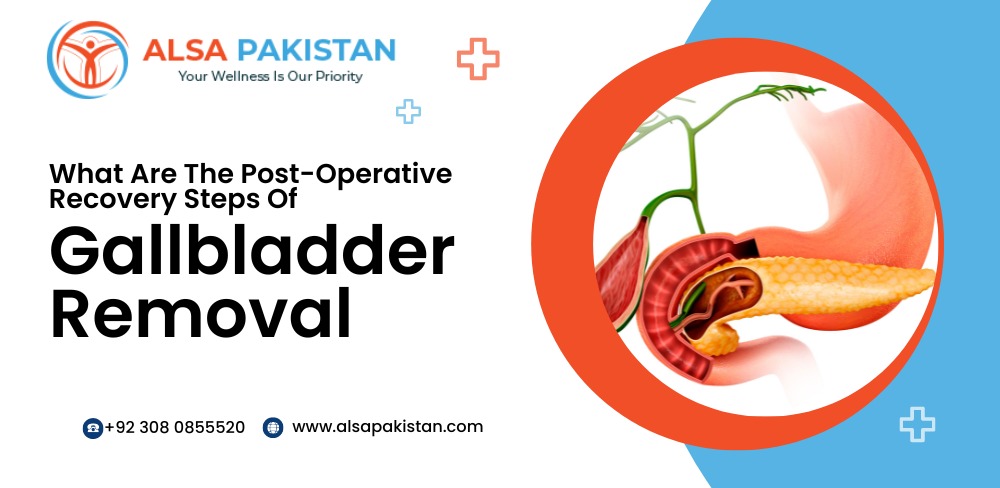
What Are The Post-Operative Recovery Steps Of Gallbladder Removal
Gallbladder removal surgery is a procedure to eliminate the gallbladder, as the name suggests. The gallbladder is a pear-like organ in the body under the liver. The primary purpose of the gallbladder is to store and concentrate bile secretion. Also, bile is a liquid that helps in the digestion of fats and carries toxins excreted by the liver. This surgical procedure is also called a cholecystectomy. A cholecystectomy is a very common procedure with less risk of complications. So, in most cases, the patients go home on the same day of the procedure. By following the post-operative recovery steps, you can have a speedy recovery.
Why is there a need to remove the gallbladder?
Surgeons recommend the removal of the gallbladder if you have the:
- Gallstones (cholelithiasis)
These are small stones formed in the gallbladder due to an imbalance of the substances in the bile. These stones block the flow of bile out of the gallbladder into the digestive system. This blockage causes cholecystitis which is inflammation of the gallbladder. Gallstones can cause problems in the other parts of the body when they move around. Removal of gallbladder stones can help relieve the symptoms of cholelithiasis.
Symptoms of gallstones
❖ Bloating
❖ Fever
❖ Nausea
❖ Pain in the abdomen
❖ Jaundice
-
Gallstones in the bile duct (choledocholithiasis)
The duct that carries the bile gallbladder is known as the bile duct. This is the condition in which patients have gallstones in their bile duct. Gallstones obstruct bile flow in this narrow passageway, leading to pain, nausea, and also some serious complications.
Have a look into testosterone booster side effects.
Symptoms of choledocholithiasis
Sometimes there are no symptoms. Unless the gallstones block the duct completely, the patients may never know they have this condition. The sign of choledocholithiasis is biliary colic which is accompanied by
❖ Nausea and vomiting
❖ Abdominal pain
❖ Jaundice and fever
-
Inflammation in the gallbladder (cholecystitis)
Inflammation of the gallbladder is called cholecystitis. In most cases, gallstones block the tube leading out of the gallbladder. Also, this blockage results in a buildup of bile which causes inflammation.
Other causes of cholecystitis are:
❖ Bile duct issues
❖ Tumours
❖ Infections
Symptoms of cholecystitis
❖ Severe pain in the abdomen
❖ Tenderness in the abdomen
❖ Nausea and vomiting
❖ Fever
-
Gallbladder polyps
The growths on the gallbladder’s inside lining are known as gallbladder polyps. Most of the time, these are benign and have no symptoms. Moreover, the cause of gallbladder polyps may be inflammation, excess cholesterol deposits, or abnormal growth of the cells.
Symptoms of gallbladder polyps
Commonly there are no symptoms of gallbladder polyps, but they cause
❖ Inflammation of the gallbladder wall when a polyp develops in the cystic duct
❖ Inflammation of the bile duct when a piece of polyp breaks off and obstructs the bile flow
❖ Inflammation of the pancreas
❖ Nausea and vomiting
❖ Fever
❖ Abdominal pain
-
Pancreatitis (pancreatic inflammation)
Pancreatitis may occur in acute form, suddenly appearing and lasting for days. Some patients develop chronic forms of Pancreatitis, which occurs over many years. Moreover, mild cases of this condition improve with treatment. But severe conditions can cause life-threatening complications.
Symptoms of Pancreatitis
❖ Upper abdominal pain
❖ Abdominal tenderness
❖ Fever
❖ Rapid pulse
❖ Nausea and vomiting
❖ Losing weight without any effort
❖ Oily and smelly stool
Types of gallbladder surgery
There are two main types of gallbladder removal surgery.
-
Laparoscopic surgery
During laparoscopic cholecystectomy, surgeons:
- Make small incisions by the belly button and on the right side of the tummy of the patient.
- Insert a small tube into one of the incisions and also pump gas inside the tummy to make it easier to access the gallbladder.
- Insert a laparoscope through one incision, which also allows them to see the inside of the abdomen on the monitor.
- Remove the gallbladder with special surgical instruments.
- Close the incisions with stitches and cover them with dressings.
The patients can go home later the same day. So, recovery from laparoscopic cholecystectomy usually takes about two weeks.
-
Open surgery
During the open procedure, the surgeons:
- Make a large incision in the abdomen underneath the ribs.
- Remove the gallbladder with surgical instruments. ‘
- Close the incision with stitches and cover it up with dressing.
The patients must stay in the hospital for a few days after the open cholecystectomy. So, the recovery after the procedure takes about six to eight weeks.
Surgeons perform both surgical procedures under general anaesthetic, and they are equally effective.
Post-operative recovery steps after cholecystectomy
After the gallbladder removal surgery, surgeons highly recommend the following steps.
- Breathe deeply to minimize the risk of developing pneumonia after the surgery.
- To promote early mobility, refrain from lying in bed for a long. Sit up straight and slowly walk around without provoking any discomfort and pain.
- If you feel pain at the surgical site when you change position, use a pillow to alleviate pain. Take a painkiller or apply pain management at once. Do not wait until the pain gets worse.
- If you underwent laparoscopic cholecystectomy, you might experience pain or discomfort caused by excessive gas used to inflate the abdomen during the surgical procedure. So, continuous mobilization can help relieve the pain.
- Be sure to attend the follow-up appointments with the surgeon.
Post-operative recovery steps to be followed at home
- Consume high-fibre foods and drink plenty of water to avoid constipation.
- Resume daily tasks and activities to stay mobile and avoid blood clots, especially in the legs.
- Avoid lifting heavy objects and strenuous exercises for at least 4-6 weeks after the surgery.
- Keep the incision site clean and follow the surgeon’s instructions on replacing the bandages.
- Minor bleeding from the incision site is common. However, immediately call for medical assistance in case of too much bleeding.
- Avoid wearing tight clothes to prevent wound irritation. So, these post-operative recovery steps can help you speed up the healing process.
Gallbladder removal in Lahore
Gallbladder removal is often a safe and also effective surgical procedure in adults and children. Moreover, advanced medical developments and post-operative recovery steps can help you return to routine life. ALSA Pakistan is the best place in Lahore for cholecystectomy.
Gallbladder Surgery Cost in Pakistan is now affordable to you because of the efforts of a team of professionals at ALSA. We have state-of-the-art medical equipment and trained staff to provide the best medical care possible.







